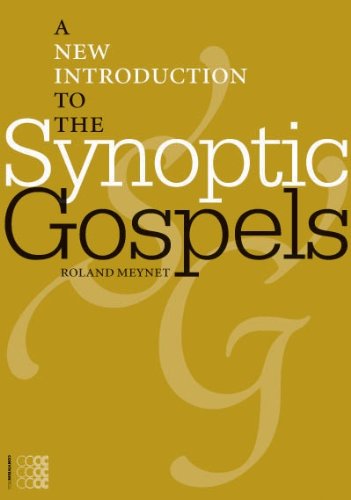Book review: A New Introduction to the Synoptic Gospels
by Roland Meynet
★★★★
This book is not what I was expecting when I saw the title! Wow. When Meynet titled his book an introduction, he didn’t mean he’d be providing a surface description. He meant that after you work your way through 415 pages of analysis, you’ll have barely turned the cover on the Synoptics.
You can give a man a fish, and feed him for a day. Or, you can teach him to fish, and feed him until they quit stocking the pond. This book is meant as a university text, to teach you how to analyze the Bible as a linguist, by taking note of the links which tie the pericopes together, and trying to grasp the logic which connects them. It’s a relatively new approach to Biblical study, sometimes at odds with the historical-critical method and normal form criticism. My rating of four stars does not represent my reading enjoyment, but rather, the teaching technique and depth of study. Reading Meynet’s book is not fun; it’s work.
Seriously. You’re going to study primarily two Bible pericopes in these 415 pages: the healing of the blind man at Jericho, and the calling of the rich man . You’ll study them in context, noting each text’s sub-sequences, carefully grinding out their meaning through rhetorical analysis of all three Synoptics.
This exhausting technique does yield results. As a simple example of the strength of this type of literary Biblical analysis, consider the story of the blind man at Jericho, as told in the Gospel in Mark. Or were there two blind men healed, as Matthew relates? Exegetes in the past have wondered which version is historically accurate; Matthew or Mark? But the question misses the point of the passage. Contextual analysis to the rescue: By reading up just a little bit, in both Matthew and Mark, we find the story of the sons of Zebedee, James and John, requesting that they sit on the right and the left of Jesus when he comes into his glory. Matthew has recognized the context, and aided in its interpretation by changing one man into two. The story of the blind man has become the story of two blind men in Matthew, and we now recognize the blind men as James and John.












 354 Circles
354 Circles
 603 Goodreads Friends & Fans
603 Goodreads Friends & Fans

 Hello! I'm an author, historical Jesus scholar, book reviewer, and liberal Christian, which means I appreciate and attempt to exercise the humanitarian teachings of Jesus without getting hung up on any particular supernatural or religious beliefs.
The Bible is a magnificent book that has inspired and spiritually fed generations for thousands of years, and each new century seems to bring a deeper understanding of life’s purpose. This is true of not only Christianity; through the years, our age-old religions are slowly transforming from superstitious rituals into humanitarian philosophies. In short, we are growing up, and I am thrilled to be riding the wave.
I avidly read all thought-provoking religion titles. New authors: I'd love to read and review your book!
Hello! I'm an author, historical Jesus scholar, book reviewer, and liberal Christian, which means I appreciate and attempt to exercise the humanitarian teachings of Jesus without getting hung up on any particular supernatural or religious beliefs.
The Bible is a magnificent book that has inspired and spiritually fed generations for thousands of years, and each new century seems to bring a deeper understanding of life’s purpose. This is true of not only Christianity; through the years, our age-old religions are slowly transforming from superstitious rituals into humanitarian philosophies. In short, we are growing up, and I am thrilled to be riding the wave.
I avidly read all thought-provoking religion titles. New authors: I'd love to read and review your book!
 Hi! While Lee writes the articles and reviews the books, I edit, organize, and maintain the blog. The views expressed here are Lee's but I'm his biggest supporter! :-)
Hi! While Lee writes the articles and reviews the books, I edit, organize, and maintain the blog. The views expressed here are Lee's but I'm his biggest supporter! :-)
Connect With Me!